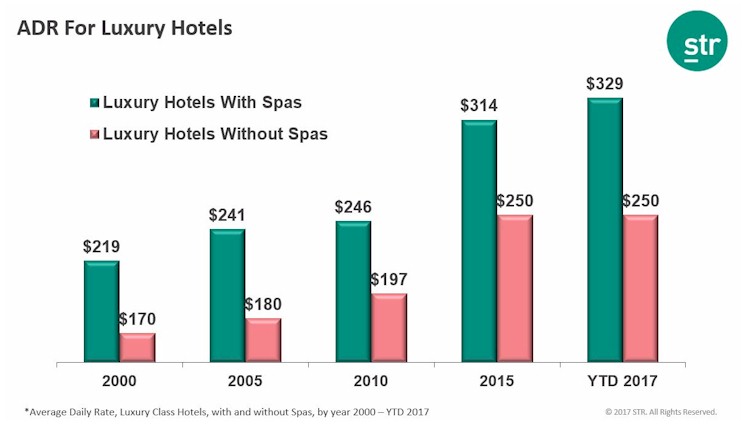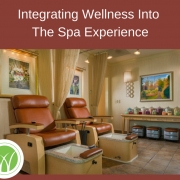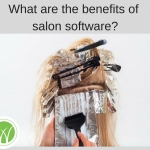Integrating Wellness Into The Spa Experience
According to the Global Wellness Institute’s 2017 Global Wellness Economy Monitor, from 2013 to 2015, Hotel/Resort spas were the fastest-growing category among all spa types, due to the emerging global middle class and a growing interest in experiential travel.
While massage will typically be the most-requested service in almost every spa, it has also become more of a commodity, with massages available in a wide variety of venues, including on-call services that deliver a therapist to your home, through an app, in under an hour. The hotel and resort spa-going guest is looking for innovation in treatments, facilities, cuisine and activities that will help them to lower their stress levels and unplug from their demanding lives, while reinforcing their brand loyalty and desire to return.
Spa Facilities

Spas are intended to be sensory havens, beyond the basic element of touch inherent in treatments, and this can’t be forgotten in the design, decor and sensory appeal of the facility. COMO Shambhala spas around the world all carry their signature Invigorate products, scented with a blend of eucalyptus, lavender, peppermint, and geranium, and these products are also used as amenities in guest rooms. Langham Hotel’s Chuan Spas each feature a signature Moon Gate entrance, and elements of Traditional Chinese Medicine are used throughout the spas, including customizable lighting in treatment rooms which are programmed based on the results of a client intake questionnaire, making the experience much more personalized. Effective air ventilation, soundproofing, and thoughtful design and furnishings will heighten the relaxation response of the guest before they even enter the treatment room.
Facility amenities including saunas, steam rooms, cold plunges and whirlpools, experience showers, and zero-gravity loungers, while not inexpensive to create and operate, provide an array of options that attract guests to the spa, and don’t have an attached labor cost. For example, the Spa Wave table by German manufacturer Gharieni offers heat, gentle vibration and a binaural sound wave system, experienced through a headset, which provides deep relaxation in a matter of minutes, without a therapist. The table can be used for typical spa treatment, but the guest can pay an additional fee to linger and enjoy these features. The Ame Spa at Turnberry Isle in Aventura, FL recently installed a cryotherapy capsule, which delivers a blast of ice-cold air in a 3-minute period, intended to boost metabolism and energy, improve circulation and relieve pain. Floatation therapy, either in a capsule or purpose-built shallow pool, calms brain waves by removing the senses of light, sound and gravity, and can be experienced at the Agua Serena Spa at the Hyatt Regency Indian Wells, CA.
The ultimate in integrating facility and design with wellness practices may be the new Six Senses Bhutan, which will be comprised of five separate lodges across the kingdom, each designed around one of the five pillars of Bhutan’s Gross National Happiness Index, and intended to be enjoyed as a circuit experience.
Tranquility lounges offering healthy snacks and refreshments, such as fresh and dried fruits, nuts, protein bars and infused-waters is an easy way to provide a connection for guests between food and well-being. Park Hyatt spas have long offered guests a chef-created amuse bouche to accompany their treatments. Today’s spa guests are very interested in herbal and botanical teas and tinctures, making an updated selection of fresh organic teas and ready hot water a must.
Spa Treatments
When it comes to the treatments themselves, it is crucial to consider the type of overall experience you are hoping to provide to your guest. Certainly, the menu will be rostered with a variety of massages and facials, but care should be taken to give these a particular local or indigenous flavor. The Spa at Colonial Williamsburg, in a locale full of history buffs, features signature treatments categorized by century, from 18th through 21st, such as the 18h Century Colonial Orange Ginger Scrub and Massage, or the 20th Century Water Experience, a bath with sweet birch flakes followed by a massage with arnica. The Wellhouse Spa at Blackberry Farm (Walland, TN) offers 4 rotating signature treatments based on the season; for instance, in the fall you would enjoy a Harvest Time treatment, featuring a steam bath, massage with warmed oil with ginger and a facial with pumpkin exfoliant, and a walnut & honey moisturizer. Guests at The Salish Spa at Salish Lodge & Spa (Snoqualmie, WA) can work with a spa mixologist to create their own body scrub using honey grown at the resort’s on-site apiary. These kinds of experiences build on the foundation of traditional massages and facials to create unique and exclusive wellness journeys with a deep connection to the property.
Urban locations may find a challenge in having an herb garden, but can instead build upon the needs of the urban guest. The Ritz-Carlton Spa in Los Angeles created a Power Lunch option, available from 11-2 weekdays, which are typically slower times in a city spa. Clients receive a delicious bento box lunch and a choice of one of three 25-minute treatments, Skin Quench Facial, Rush Hour Massage, or Reflexology. The package includes valet parking so ensure that the guest can complete the experience in one hour. The Peninsula Spa New York showcases a head-to-toe Red Carpet Ready package, consisting of a facial, body scrub & wrap, and a shampoo and blow-dry, and makeup application at the on-site salon, and including a healthy lunch and glass of champagne.
Spa Parties & Membership
For hotel spas with fitness and wet facilities, a perfect solution to attract locals and create revenue can be a membership program. Charging an initiation fee as well as monthly dues, much like a fitness club, members can use the fitness floor, pool and locker rooms, and typically receive discounts on spa treatments and products; some benefits will extend to F&B or room discounts in the property. Langham’s Chicago Chuan Spa members can take part in over 25 weekly fitness and wellbeing activities, seasonal social activities and wellness lectures, and receive access to the club floor lounge, with free wifi, work areas, and a breakfast buffet. Langham’s Regional Director of Spa & Wellness, North America William Wesley Myers comments that “People love being a member of something exclusive; especially in the luxury market segment. A well-structured spa membership program has the ability to ensure a steady cash flow with direct impact to the bottom line, offsetting higher fixed costs associated with a hotel spa. Membership can also steer business to low demand periods, increase revenues with new availability in high demand periods, build local loyalty and net promoters, and additionally give operators an engaged client base to sell and market new offerings and promotions.”
The Joya Spa at the Omni Scottsdale Resort & Spa at Montelucia’s membership program offers discounts on room rates, spa treatments and cabana rentals, and access to preferred parking. Membership programs can also restrict access to low-impact times of day or days of the week, preserving the peaceful spa environment that hotel guests are seeking, while providing a steady stream of income for the business.
Social Atmosphere in the Spa
In hotel locations that cater to a business crowd, marketing plans that attract guests to the spa for evenings and weekends can be a great way to build foot traffic. In Miami Beach, the Confidante by Hyatt recently launched a monthly Spa Nights experience. Guests are invited on the last Friday of each month to the spa’s open-air rooftop for a complimentary glass of champagne, special pricing on spa treatments, and an upbeat musical playlist, making for a fun vibe. W Las Vegas features energizing ambient music, and adjustable LED lighting and choice of playlists in treatment rooms permits guests to participate in creating the environment most suited to their needs. W Hotels are also beginning a weekend program building on the fitness and wellness needs of the millennial guest, Fuel weekends by W Hotels. These weekends will feature access to top global trainers and experts in an array of fitness disciplines including yoga, boxing, surfing, and HIIT, combined with healthy cuisine and socializing at evening parties with open bar at the pool, and DJ’s, and guests can add on extras such as spa treatments and excursions.
Wellness Marketing
At the opposite end of the spectrum, Mandarin Oriental Group Director of Spa & Wellness Jeremy McCarthy shares that their hotels have, for the last few years, been offering a “Silent Night” event in their spas around the holidays, with no talking and no music in the spa for one night only. “It is intended to get people thinking about the scarcity of silence in the modern age and the opportunities to use a spa as an escape from the noise. It is not a revenue-generating event for the spas though, more of an awareness campaign.” says McCarthy. In addition, Mandarin Spa guests can enjoy the Digital Wellness Retreat; an 80-minute experience that begins with an antioxidant mineral bath soak, and then delivers a massage which concentrates on the head, eyes, neck, shoulders, hands and feet, but can be customized to each guest. Guests who surrender their mobile devices will have a cleaned and repackaged phone returned to them, having enjoyed a spa treatment of its own! Mandarin’s latest initiative is in partnership with the company Grokker, which has supplied digital content such as fitness, pilates and yoga sessions, including a soothing bedtime yoga routine, and a five-minute guided meditation, which guests can access from the privacy of their rooms.
Four Seasons Los Angeles at Beverly Hills is currently testing a pilot program consisting of “wellness rooms,” in conjunction with the real estate company Delos. Select rooms offer features including dechlorinated showers, healthy in-room dining menus and toiletries with natural ingredients. These rooms are commanding an ADR about $50 above the average, and the demand has been consistent. Focusing on the experiential side, The Spa at the Four Seasons Hong Kong is launching a Masters of Wellness series, in which visiting wellness experts will provide the opportunity for guests to experience a wide range of healing therapies, including Reiki Healing, Bowen Therapy, Astrology, and Aura Reading. “With Masters of Wellness, guests will have the opportunity to explore new frontiers of health, and to find the inner peace from which true beauty flows,” says Senior Director of Spa, Shoshana Weinberg.
Taking wellness to the next level, the Grand Velas group has created a “Wellnessing” concept, in conjunction with spa consultant Diana Mestre and a team of architects, designers, and hotel personnel. Says Mestre, “The Wellnessing concept addresses components of six dimensions of wellness identified by the National Wellness Institute; physical, spiritual, intellectual, social, emotional and environmental. Components including in-room exercise equipment, healthy mini-bars, a wellness TV channel, personalized aromatherapy, group activities and an optional spiritual cleansing, among a long list of available options, allow guests to enjoy a wellness journey that meets their specific needs and brings a new level of wellbeing to the Grand Velas guest.”
Successful Spa Operations
As many hotel operators have discovered, spa success is not automatic, and not conferred just by adding “spa” to the hotel name, although that certainly helps. Hotel spas with a clear mission, purposeful design and effective branding are better able to attract the guest, and the elevated ADR that comes with having a spa. Numerous cross-marketing opportunities can be created between the hotel spa and other departments, including F&B, Sales, & Rooms.
Advises consultant Lynn Curry, of Resources for Leisure Assets, “With any new development including, for example, a Spa and Fitness facility, it’s imperative that not just the RevPar, but the TrevPar is assessed in order to identify the value and ROI to the entire development. Whether a spa, fitness center, wellness center, or recreational component, it has to add value to the property through guest experience, added revenue, value-added potential, word of mouth advertising, and other key metrics (length of stay, room rate, group attraction, repeat business). When properly assessed, the wellbeing hospitality asset can bring substantial revenues to a hotel or residential project. In the North American market, we are seeing group and social areas within the spa facility, attracting a new kind of business, which brings additional revenues through F&B, multiple treatments per person, and the encouragement of a “staycation”. These are great opportunities to bring business to the property during off-peak, or slower times, as long as the ROI per square foot has been assessed.”

Let’s talk about adding Wellness to your spa. Contact us for a complimentary consultation.
“Reprinted from the Hotel Business Review with permission from www.hotelexecutive.com.”




Leave a Reply
Want to join the discussion?Feel free to contribute!